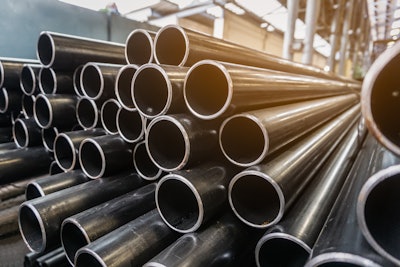
The prices of steel witnessed a steep incline of 2.5x for hot rolled coil (HRC), reaching >USD2,100/MT in 4Q21, while those of cold rolled coil (CRC) and hot dipped galvanized (HDG) coil steel went up 2.3x and 2.8x. This can be largely ascribed to limited supply, sharp rise in raw material and energy costs, increasing ocean freight costs, and growing demand across end-use industries, in particular mobility, industrials, and construction. Prices are expected to remain at high levels throughout 2022, with the average price projected to increase 5–7% until 4Q22 vis-à-vis 1Q22.
Drivers of price hike
Surge in raw material price
Iron ore prices soared 1.7x in the past two years on account of dwindling supply and rising demand, reaching USD142.5/MT in 1Q22 (until February) for 62% Fe grade. Although some relief was witnessed in 4Q21, the prices saw a steep rise of >30% in 1Q22 (until February). Continued supply constraints from mining firms (Vale, Rio Tinto) due to lower production, speculative trade with regard to iron ore inventories, and trading have been the underlying reasons for the price hike.
Iron ore prices are likely to gain in 2022 on renewed demand due to the stimulus package for the infrastructure sector. On the supply side, there is no significant increase in iron ore supply anticipated from major producers, which is likely to keep steel prices elevated in 2022.
Decreased iron ore production
Total iron ore production from top producers globally either declined or remained flat in 2021. Australia- 35%, Brazil- 15%, and China- 14% share in global iron production, together control 60–65% of the total iron ore supply. The iron ore production with these 3 economies showed no increase in 2021. In fact, production in Australia declined by 12 million tons, Brazil by 8 million tons, while China observed no increase vis-à-vis 2020.
The iron ore supply crunch is expected to persist since miners such as Vale would take longer to return to normal capacity levels, coupled with sluggish exports from Australia, potentially supporting the continued price uptrend in 2022.
Rising cost of energy
Energy accounts for around 15% of the overall production cost of steel. Increasing energy prices have forced steelmakers to explore other options to offset the rising production costs by either raising steel prices or introducing energy surcharges (especially in Europe). In Europe, gas prices have surged >8x while power costs soared 5x. In addition, given limited gas supply on account of the ongoing Russia-Ukraine crisis, there is no immediate relief in sight.
Industrial electricity prices in China reached CNY0.69/kWh in January 2022 from CNY0.18/kWh in January 2021, following dual control policy implementation and higher carbon prices (CNY56.9/MT). The cost of electricity for industrial consumers in Brazil rose to BRL0.77/kWh from BRL0.69/kWh in January on account of the huge water crisis in 2021. On the other hand, prices in Australia dropped 13% to AUD0.27/kWh in 2021 but are expected to increase with the corresponding rise in fossil fuel prices.
Rising energy costs, along with increased focus on carbon emission reduction, are expected to support the increased prices in 2022 as well.
Increase in logistics cost
Ocean container freight rates went up drastically after the pandemic, up >280% in 2021. The spike in rates is attributed to several factors such congestion at destination ports, increase in bunker fuel prices, and continued supply chain disruption.
Logistics costs have risen sharply by 5–8x from Asia/the US to Europe. For example, ocean freight rates from Asia to North Europe stood at $14,000–16,000 per 40 ft container in 2021, which is 450–500% higher than 2020 levels. The record-high bunker fuel prices (up 55% in 2021) and poor schedule reliability leading to increased congestion of ships are pushing up ocean freight costs and strongly affecting overall commodity prices.
The ocean freight rates are expected to stay elevated on account of no immediate ease in supply chain imbalance, risking bunker fuel charges and inflation, continued port congestion, canceled port calls, and surge in an unstable competitive environment on account of rising differential between the low and high range of charges paid by shippers.
Potential surge in demand with improving economic scenario
Demand for steel is estimated to grow 2.2% to 1,896.4 million tons in 2022, as per the Short Range Outlook by World Steel Association. Anticipated strong growth across manufacturing activities, supported by pent-up demand, would potentially boost steel demand.
In 2022, demand would be primarily driven by the Middle East and Africa, with >6% expected growth, followed by Europe (5.8%) and North America (5.3%).
Potential recovery in the automotive sector; increase in industrial and construction activities; and growing demand in the equipment/machinery, consumer durable, and energy sectors are expected to fuel steel demand.
Conclusion
Pressure on the steel supply market is not expected to ease in the next six months, wherein the rising cost of energy, raw materials, and logistics would support the elevated steel prices globally. Furthermore, continued focus on energy conservation, government targets for curbing carbon emission, and the need for implementation of efficient steel production techniques would keep pushing the prices higher. Regional developments such as the Chinese government’s cap on annual production, together with escalating geopolitical issues such as the Russia-Ukraine war, would worsen the situation.
Demand for specific grades of steel that has high strength/ultra-high strength across end-use industries, such as construction and automotive, would also drive the prices. Therefore, prices are projected to cross the USD2,300/MT mark for HRC, USD2,500/MT for CRC, and USD3,200/MT for HDG coil steel until 4Q22.









